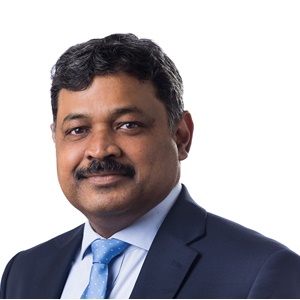Invited Speakers

Applications of Digital Twin for Autonomous Zero-Touch Optical Networking
Marc Ruiz Ramírez, Assistant Professor, Universitat Politècnica de Catalunya (UPC)
Huge efforts have been paid lastly to study the application of Machine Learning techniques to optical transport networks. Applications include Quality of Transmission (QoT) estimation, failure detection and attack detection, and network automation, just to mention a few. In this regard, the development of Optical Layer Digital Twins able to accurately model the optical layer, reproduce scenarios and generate expected signals are of paramount importance. In this paper, we will overview several applications of Digital Twins, including QoT estimation, failure management, and anomaly detection.
Important Dates
Submission deadline (firm): 20 Dec. 2022; 20 Jan. 2023; 27 January 2023
Acceptance notification: 10 March 2023
Camera-ready submission: 20 March 2023
Conference date: 08-11 May 2023
Latest News
Platinum sponsor
ONDM 2023 was sponsored by Huawei Technologies France SASU
Platinum sponsor
Gold sponsor
Silver sponsor
Organization
Technical co-sponsorship
Supported by
Self-Autonomous Multi-Carrier Optical Transmission
Andrea Sgambelluri, Assistant Professor at TeCIP Institute, Scuola Superiore Sant’Anna, Pisa, Italy
In order to activate high-data-rate connectivity, super-channel transmission strategy is becoming a suitable solution. Optical Software Defined Networking (OSDN) architecture leverages NETCONF protocol for the configuration and management of optical devices. To support a vendor-neutral approach, OpenConfig YANG models are adopted in the NETCONF communication. In OpenConfig, all the proprietary parameters (i.e., FEC, bit rate, modulation format) are mapped to operational modes, maintaining a basic compatibility between vendors. In this work, the experimental analysis of an automatic super-channel optimization is shown. In particular, for each established super-channel, the sub-carriers are partially overlapped and tightly filtered, achieving spectrum saving with margins reduction, while guaranteeing a level of Quality of Transmission (QoT). The procedure has been demonstrated using an SDN Controller with an SDN-based Optical Network, including OpenConfig 600 Gbit/s transponders and emulated ROADMs. After the setup of a lightpath, the optimization procedure is activated by the transponder agents, without involving the SDN controller, to find the optimal super-channel configuration, according to the reach and the desired modulation formats. A spectrum saving of 25% is achieved with respect to the nominal conditions, still guaranteeing the minimum QoT level for the channels involved, in terms of pre-FEC-BER.


Targeted Defragmentation of a Production Optical Network
John P. Eason, Network Modeling and Optimization Engineer, Meta , USA
Organic growth of optical networks can create fragmentation of spectrum resources over time and lack of continuous and contiguous spectrum can block turning up additional capacity. Demand growth may require capacity augmentation and delays could result in production risk and potential deterioration of user experience. In this work, we present a ILP framework that can provide the defragmentation plan for a targeted portion of a production optical network, unblocking capacity through remote reconfigurations, thereby helping with retaining backbone resilience despite mobility restrictions during the pandemic.
Free-Space Optical Communications for Next-Generation Wireless Systems
Paulo P. Monteiro, Associate Professor, University of Aveiro, Institute of Telecommunications, Portugal
Next-Generation Wireless Systems, 6G and beyond, will require support to peak bit-rates in the Terabit-per-second range, which will challenge the physical limits of standalone radio-frequency communications. To unlock the capacity of next-generation wireless systems, novel free-space optical communications are currently under development. In this talk, we will review our latest work on visible-light and near-infrared optical wireless transmission delivering bit-rates up to 1 Tbps, leveraged by the use of advanced modulation/coding, digital signal processing, channel modelling/estimation and machine learning techniques, with the aim of supporting the foreseen 6G requirements of ultra-high-capacity and reliability at the physical layer.


Ontology driven approaches to cybersecurity of 5G networks
Marina Settembre, Senior Researcher, Scientific Direction, Fondazione Ugo Bordoni, Rome, Italy
The digital threat landscape poses more and more challenges to protect information systems and communication networks against different types of attacks, including Advanced Persistent Threats. (APT). New approaches and tools for risk and vulnerability assessment and threat modeling to handle a growing complexity and increasing number of heterogeneous sub-systems changing over time (e.g. updating, substitution or integration of components) and a higher level of automation are needed. Cybersecurity ontology is not a new concept, but recently it is gaining a renewed interest witnessed by a growing number of papers in the technical scientific literature and other initiatives carried out by several agencies and organizations (e.g., ENISA, NIST, MITRE). A common and controlled taxonomy and a machine-readable and human- understandable conceptual models, including entities, attributes, and relationships, can be useful for a real time view of network services and network elements and for knowledge reasoning aiming at a continuous adaptive critical vulnerability and risk assessment and knowledge re-use in threat intelligence and guiding decision-making processes. Current proposed ontologies are focused on specific, but still fragmented, issues and there is an ongoing debate whether and where ontologies driven approaches can be more useful or necessary. In the paper, without claiming to be exhaustive or definitive, the state of the art and the perspectives of ontology driven approaches will be presented, with preliminary insights on 5G security domain, referring to proposed threat taxonomy for 5G networks and location of the exploitation’s target in 5G networks.
Quantum Cloud with Communication, Computing, Caching, and Cipher (4C) Resource Coordination
Qingcheng Zhu,
State Key Lab of Information Photonics and Optical Communications, Beijing University of Posts and Telecommunications, China
With the rapid development of the cloud computing and caching paradigm, many businesses are migrating all their information technology (IT) services to cloud providers. The security of the data transmission in such paradigm is critical, especially for the confidential and sensitive data. The traditional cryptography based on computational complexity faces the security threats from quantum computers. Quantum key distribution (QKD) based on the principles of quantum physics enables symmetric keys sharing between remote users with information-theoretic security. The QKD systems integrated in the cloud infrastructure to form a quantum cloud will help to improve the data communication security to a large extent.
In the quantum cloud, the interconnected cloud datacenters (DCs) provide communication, computing and caching resources for data transmission, processing and storing; the QKD systems co-located with DCs supply cipher resources for enroute data encryption and decryption. These resources are usually shared by multiple users and dynamically reallocated per service. The communication, computing, caching and cipher (4C) resource allocation problem needs to be solved in this context. In this paper, the coordination-based 4C resource allocation (Co4CRA) algorithm is proposed to ensure the service quality and network performances in the quantum cloud. The simulation results show that the proposed algorithm achieves the great success ratio performance compared with the baselines not considering the 4C resource coordination.


Approaches to dynamic provisioning in multiband elastic optical networks
Alejandra Beghelli, Lecturer of Optical Communications and Networks, Optical Networks group, Electronic & Electrical Engineering Department, University College London, UK
Dynamic multi-band elastic optical networks are envisaged to address the need for increased optical capacity by allocating capacity only where and when needed (dynamic), by using the spectrum beyond the C-band (multi-band) and by allocating only as much spectrum as needed (elastic). Such potential has triggered interest in how to better design provisioning algorithms in such networks. In this paper, heuristics and reinforcement learning approaches for dynamic provisioning in multi-band elastic optical networks will be reviewed and evaluated.
Wideband transmission in low core-count multi-core fibers
Ben Puttnam, Chief Senior Researcher, Photonic Network Laboratory, National Institute of Information and Communications Technology (NICT), Japan
Utilizing the additional transmission bandwidth of the S-band can add hundreds of WDM channels and lead to record fiber throughputs for short-reach and long-haul transmission, but adoption lower wavelength bands may also allow MCFs with lower crosstalk and increased spatial density.


Cascading-failure-aware disaster recovery in Optical Cloud Networks
Juliana de Santi, Assistant Professor. Federal University of Technology – Paraná (UTFPR), Curitiba, PR, Brazil
In Optical Cloud Networks the cloud services requested by source nodes are provided in data center (DC) nodes. Given the diversity and importance of these services for our society, providing resilient optical communication services even during large-scale disasters is crucial to guarantee adequate access to these services. Disaster events can affect the optical cloud with multiple failures of nodes and links. Moreover, the damage to critical infrastructure elements can subsequently overload and affect other elements, defined as post-disaster cascading failures, with severe consequences. Therefore, it is crucial to investigate disaster cascading failures, draw conclusions about their impact on service availability as well as propose solutions. In this study, we propose a restoration-based survivability strategy, which combines the benefits of service relocation and the awareness of cascading failures risk. The former aims to increase the number of successfully restored cloud services, while the latter decreases the risk of disconnections due to cascading failures. Simulation results and future directions are discussed.
Next Generation PON Technologies: 50G PON and Beyond
Derek Nesset, Optical Access Research and Standards, Huawei Technologies, UK
In recent years, network operators worldwide have been upgrading their fiber-to-the-home networks from Gigabit-class PON systems to 10G-class. Naturally, the industry has also been working on the next evolution step for PON systems beyond 10G. At the ITU-T, this next step is defined by the Higher-Speed PON systems operating at 50 Gbps line rate. This paper reviews the standardized 50G-PON system and related technologies and what might come next for optical access.


Packet-optical transport for vertical services in the path to 6G
Piero Castoldi, Professor at TeCIP Institute, Scuola Superiore Sant’Anna, Pisa, Italy
The evolution towards 6G impacts the transport network in several aspects: RAN and Core Network will be characterized by high modularity and cloudification; the increasing deployment of services for vertical industries requiring E2E QoS (throughput, latency, availability, reliability) according to the related SLA, including services with extreme performances to be supported from a local to a geographical dimension; the evolution of new radio deployments to enable very dense areas.
The main challenge for the transport is guarantee E2E QoS avoiding over-provisioning to reduce cost for bit. This implies to handle the services with mostly automatic operations and to increase the optimization of the network resources. The right combination of packet and optical technologies allows to combine the flexibility of the packet layer with the high bandwidth and low latency of the optical layer. Anyway, simple downsizing and reusing conventional transport systems, tailored for regional and long-haul segments, does not match the constraints of cost, size and power consumption that are typical of the access area. Hence, a new paradigm is needed, based on novel technologies and on smart orchestration mechanisms that must be “transport-aware”.
To demonstrate this new transport paradigm, including the E2E slice orchestration for services, a specific case study has been investigated and assessed through a pilot hosted in the COMAU and TIM premises in Turin, Italy. An experimental area has been covered with a 5G network (RAN/CN) supported by a transport network based on optical systems to convey radio traffic with the desired E2E QoS for three different types of services. In fact, in a smart factory, many use cases shall be typically supported in a parallel manner over the same radio/transport infrastructure. More specifically, the pilot has demonstrated the support of low latency communication for synchronized digital twin, massive machine type communication for real-time asset monitoring through pervasive sensors, and immersive telepresence for technical support from a remote location.
Dynamically reconfigurable Radio over Fiber Networks for Next Generation Mobile Networks
Thas Nirmalathas, Professor, Deputy Dean Research, Faculty of Engineering and Information Technology, The University of Melbourne, Australia
Future mobile networks such as 6G would require optical crosshaul networks highly intelligent, reconfigurable, and adaptable to dynamic service requirements and network conditions within a network architecture similar to open radio access network (ORAN). To this end, we propose and investigate novel software definable and reconfigurable optical crosshaul architecture for supporting a heterogeneous mix of crosshaul transport technologies and dynamic functional splitting configurations. We will present numerical studies of this architecture to evaluate their performance against future requirements.






